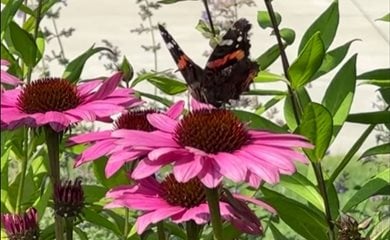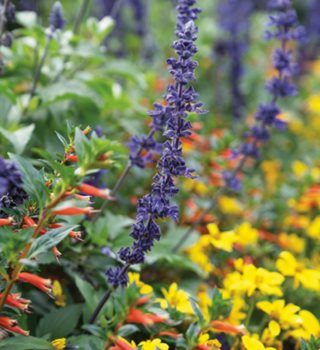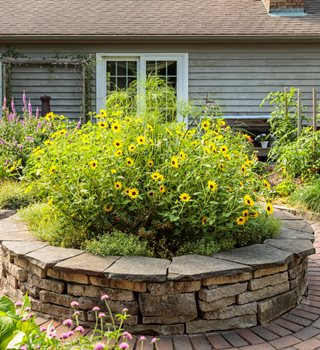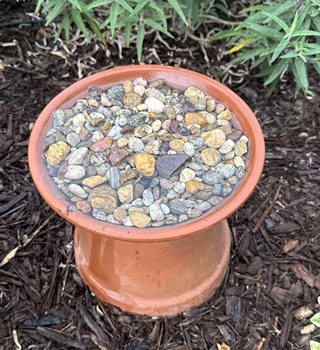10 Tips for Starting a Pollinator Garden
Learn how to grow a pollinator paradise with these tips for picking the right flowers and creating a safe, welcoming environment for beneficial insects.If you’ve been reading the news lately about the dramatically dwindling populations of honey bees and monarch butterflies, you are already aware that these and many other pollinating insects are in a serious struggle to survive. But you may not know the factors behind their alarming decline, including the loss of feeding and nesting habitats, misuse of pesticides, disease, and climate change.
Fortunately, there are many simple things you can do in your own garden to create a pollinator-friendly habitat, not only for bees and butterflies but also for other beneficial insects like moths, flies, beetles, and wasps. Your personal pollinator patch can be as small as just a few flower-filled pots or large enough to fill your entire backyard. What’s most important is that you make smart flower choices and provide optimal conditions to support a variety of pollinating insects. As a bonus, you’ll be creating a diverse, aesthetically pleasing garden filled with a variety of flowering plants that are adapted to your local climate.
1. USE NATIVE PLANTS
Native plants are more attractive to local pollinators than imported or hybridized plants because the plants and native pollinators have evolved together. Native plants are also easier to establish and will not require the use of pesticides. If you can only find a cultivated variety (sometimes referred to as a “nativar”), choose one closest to the natural form of the native plant. Not every plant in your garden has to be a native species, but you will entice more pollinators and other regional wildlife by including at least some native perennials and shrubs.
Learn more: Native Plants: How & Why to Grow a Native Plant Garden.
2. CHOOSE PLANTS WITH VARYING BLOOM TIMES
Although you may notice more pollinator activity during the summer—especially on warm, sunny days—pollinating insects are hard at work throughout the entire growing season, from the earliest days of spring to late fall. In spring, pollinators need early-blooming plants to provide food after a long winter of hibernation. And late-blooming plants give pollinating insects the reserves they need for winter hibernation and to fuel their southern migrations.
The best way to keep pollinators nourished all season long is to include a mix of annuals, perennials, and shrubs in your pollinator garden. Many warm season annuals bloom all summer, and will help sustain pollinators when there are lulls between the bloom periods of different perennials and shrubs. For plant ideas, see 30 Pollinator Plants to Grow In Your Garden.
3. PLANT FLOWERS THAT HAVE DIFFERENT SHAPES
Pollinators are drawn to certain plants because of their flower shape and size, and will seek out blooms they can feed from easily. For example, tubular or spurred flowers are often favored by butterflies that have a long proboscis (or feeding tube) because they can reach the nectar at the base of the flower. Large blooms with open petals, such as sunflowers (Helianthus spp.) are great landing pads for bumble bees and butterflies, whereas honeybees often flock to tiny flowers.
In general, the best flowers for pollinating insects are simple, single flowers with open centers that provide easy access to their pollen-laden anthers. Avoid hybrid double-flowered plants that make it more difficult for insects to reach the nectar.
4. INCLUDE A VARIETY OF COLORS
In addition to planting different flower shapes, you should also incorporate a variety of flower colors in your garden to make it more appealing to different pollinator species. Flowers in shades of blue, purple, and yellow, for example, are a surefire way to attract bees. Red, yellow, orange, pink, and purple blooms are better for attracting butterflies. Moths, which tend to feed in the evening, gravitate towards white or cream-colored flowers having sweet scents.
See: Flowers for a Bee-Friendly Garden and 25 Butterfly Garden Plants.
5. CHOOSE A SUNNY SPOT
Have you ever noticed that bees and butterflies are less active on cool, cloudy days? That’s because they are cold-blooded and need the warmth of the sun to raise their body temperature so they can get energized for all their foraging work. To attract more pollinators to your garden, locate it in a site that gets ample sunlight (at least 6 hours daily). Also provide rocks to serve as warming and resting spots.
See these four landscape recipes from Proven Winners designed for full-sun locations:
- Pollinator Garden Recipe #1
- Pollinator Garden Recipe #2
- Pollinator Garden Recipe #3
- Pollinator Garden Recipe #4
6. PLANT MULTIPLES OF EACH PLANT
Many pollinating insects prefer a one-stop feeding spot where they can find an abundance of flowers of the same plant rather than having to search far and wide for their next meal. Arranging your plants into groups will lure in more pollinators than a scattering of individual plants throughout the garden. To create a more naturalistic design, group your plants in drifts throughout your garden rather than planting them in rows.
7. MAKE ROOM FOR LARVAL HOST PLANTS
In addition to including nectar-rich flowers in your pollinator garden design, also incorporate some host plants where butterflies can lay their eggs and where the caterpillars can feed. For example, monarch caterpillars like to munch on milkweed (Asclepias spp.), while parsley (Petroselinum crispum) is a favorite food for black swallowtail caterpillars. (See this butterfly larval host plant list from Penn State Extension Service.)
Because larval host plants are meant to be eaten by butterfly caterpillars, consider planting them in an area that is out of direct sight so the damaged foliage won't take away from the ornamental appeal of your pollinator garden.
8. CREATE SAFE WATERING AREAS
Bees not only need water to stay hydrated, they also use it to regulate the temperature of the hive, feed young bees, and dilute crystallized honey. Water is essential to butterflies as well, and provides an important source of minerals critical to their diet.
To provide a spot for pollinators to land and drink water safely, without the risk of drowning, place rocks or glass beads in a shallow water-filled saucer or birdbath with sloping sides. Butterflies like to sip liquid from muddy soil (a behavior known as “puddling”) to get the salts and other dissolved minerals they need. You can make your own puddling area by placing a shallow dish on the ground or on a pedestal and filling it with a mix of dampened landscape sand, compost, and organic garden soil.
9. PROVIDE NESTING HABITATS
Once pollinators have feasted on their favorite flowers, they need a place to rest and take shelter, sometimes referred to as nesting. Bumblebees and many solitary bees nest in the ground and need open patches of bare soil. Dead wood, such as hollow logs and tree stumps, are also common nesting spots for bees, as well as wasps and beetles.
Bee and insect houses also provide nesting sites and can be purchased, or you can build your own by drilling holes approximately ¼ inch in diameter and 3 inches deep into blocks of untreated wood or a dead tree stump. To attract mason bees to your garden, look for premade nesting tubes made of cardboard, hollow reeds, or bamboo.
10. LIMIT THE USE OF PESTICIDES
The use of pesticides in your pollinator garden should be avoided as much as possible. Pesticides kill insects indiscriminately, meaning they can harm pollinators as well as the pests you are trying to eradicate. Systemic insecticides should also be used with caution. These pest-control products, which are taken up by the roots of plants, can contaminate plant tissues from the inside, potentially reaching the pollen and nectar consumed by pollinators.
As an alternative to pesticide use, try natural pest-control strategies, such as companion planting and the use of natural predators.
FREQUENTLY ASKED QUESTIONS
Check out these pollinator garden tips from Stacy @bricksnblooms.
What is the best location for a pollinator garden?
A sun-soaked spot sheltered from the wind provides the ideal environment for pollinating insects to fly and forage efficiently. Although a sunny site is best, it’s still possible to grow a pollinator garden in a shadier area. In fact, many pollinating insects will warm up in the sun and then seek out colorful shade-tolerant flowers that appeal to them.
How do you create a small pollinator garden?
Because it is more efficient for pollinators to forage in a single location where an assortment of nutritious flowers are present, a pollinator garden doesn’t have to be large in scale to satisfy their appetites. If you have limited garden space, start with a grouping of patio planters containing a mix of a native flowers and annuals. A small perennial flower bed or a small vegetable garden interspersed with flowers are other space-saving options. You can always expand your pollinator garden later if more space becomes available.
Where do pollinators go in winter?
Although some butterfly species, such as the monarch, migrate to warmer climates before winter arrives, most pollinators prefer to stay put and seek shelter from the cold. Many bees hibernate under brush piles, leaf litter and other garden debris, while others will nest in the ground, often near the garden beds where they feed. To give pollinators the winter shelter they need to survive, hold off until spring to clean up your garden rather than removing all debris and cutting back perennials to the ground in the fall. Some bees don’t emerge from hibernation until late May, according to the Xerces Society, so the longer you can wait the better.
How do I maintain a pollinator garden, keeping beneficial insects in mind?
Some conventional gardening practices you are accustomed to using elsewhere in your garden should be avoided in a pollinator patch because they can be disruptive or harmful to beneficial insects. The use of mulch, for example, can make it hard for native bees to burrow nest tunnels into the soil. If you do need to mulch to conserve soil moisture or to inhibit weeds, use a material that will break down easily, such as composted leaves. You should also avoid digging up or working the soil in your pollinator garden as much as possible because you could disturb the habitat of ground-nesting bees.
When watering your pollinator garden, try to do so at dawn or dusk when pollinators are less active. And be sure to water at ground level, since most pollinators don’t like to be “rained” on.
RELATED:
Flowers for a Bee-Friendly Garden
How to Make a Butterfly Garden
The Best Perennials for Pollinators
30 Pollinator Plants




